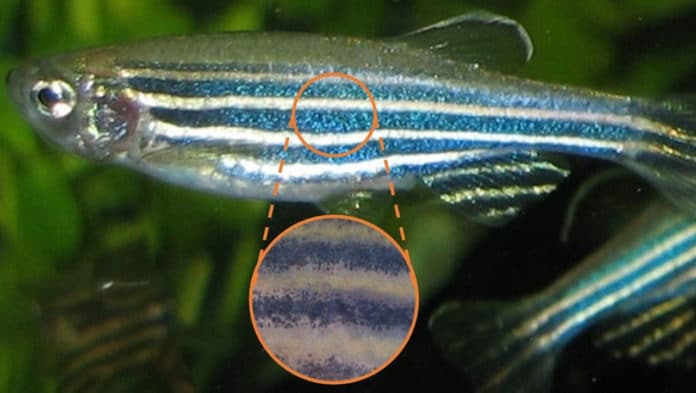About 2.5 cm to 4 cm long, the Zebrafish is recognized as an ideal model organism for investigating the cellular and molecular mechanisms. Zebrafish begin life as transparent embryos, with three types of pigment cells on their skin. As they develop, the pigment cells somehow manage to organize themselves almost without fail into the stripes we all know.
Now, scientists at the University of Bath have developed a robust mathematical model that may explain how one critical species, the zebrafish, develops its stripes.
Studying their striking appearance may, in time, be relevant to medicine, since pattern formation is an important general feature of organ development. Therefore, a better understanding of pigment pattern formation might give us insights into diseases caused by disruption to cell arrangements within organs.
Pigmentation in zebrafish is a case of a new wonder – One in which individuals (cells for this case), all acting as per their own local rules, to shape an ordered pattern at a scale larger than expected. Different instances of emergent phenomena in biology include the flocking of starlings and synchronized swimming seen in schools of fish.
Dr. Kit Yates, the mathematician from Bath who led the study, said: “It’s fascinating to think that these different pigment cells, all acting without coordinated, centralized control, can reliably produce the striped patterns we see in zebrafish. Our modeling highlights the local rules that these cells use to interact with each other to generate these patterns robustly.”
Professor Robert Kelsh, a co-author of the study, said, “Why is it important for us to find a correct mathematical model to explain the stripes on zebrafish? Partly, because pigment patterns are interesting and beautiful in their own right. But also because these stripes are an example of a key developmental process. If we can understand what’s going on in the pattern development of a fish embryo, we may be able to gain deeper insight into the complex choreography of cells within embryos more generally.”
The stripes of an adult ‘wild type’ zebrafish are formed from pigment-containing cells called chromatophores. There are three different types of chromatophores in the fish. As the animal develops, these pigment cells shift around on the animal’s surface, interacting with one other and self-organizing into the stripy pattern for which the fish are named. Occasionally, mutations appear, changing how the cells interact with each other during pattern development resulting in spotty, leopard-skin, or maze-like labyrinthine markings.
It is well known that the biological interactions needed for the self-organization of a zebrafish’s pigment cells. Still, it remains unclear whether these interactions offer a comprehensive explanation for how these patterns form.
The model consists of three cell types and all their known interactions. The model has proven successful, predicting the pattern development of both wild type and mutant fish.
Jennifer Owen, the scientist responsible for building and running the model, said, “One of the benefits of our model is that, due to its complexity, it can help to predict the developmental defects of some less understood mutants. For example, our model can help to predict the cell-cell interactions that are defective in mutants such as leopard, which displays spots.”
The study is published in eLife.
